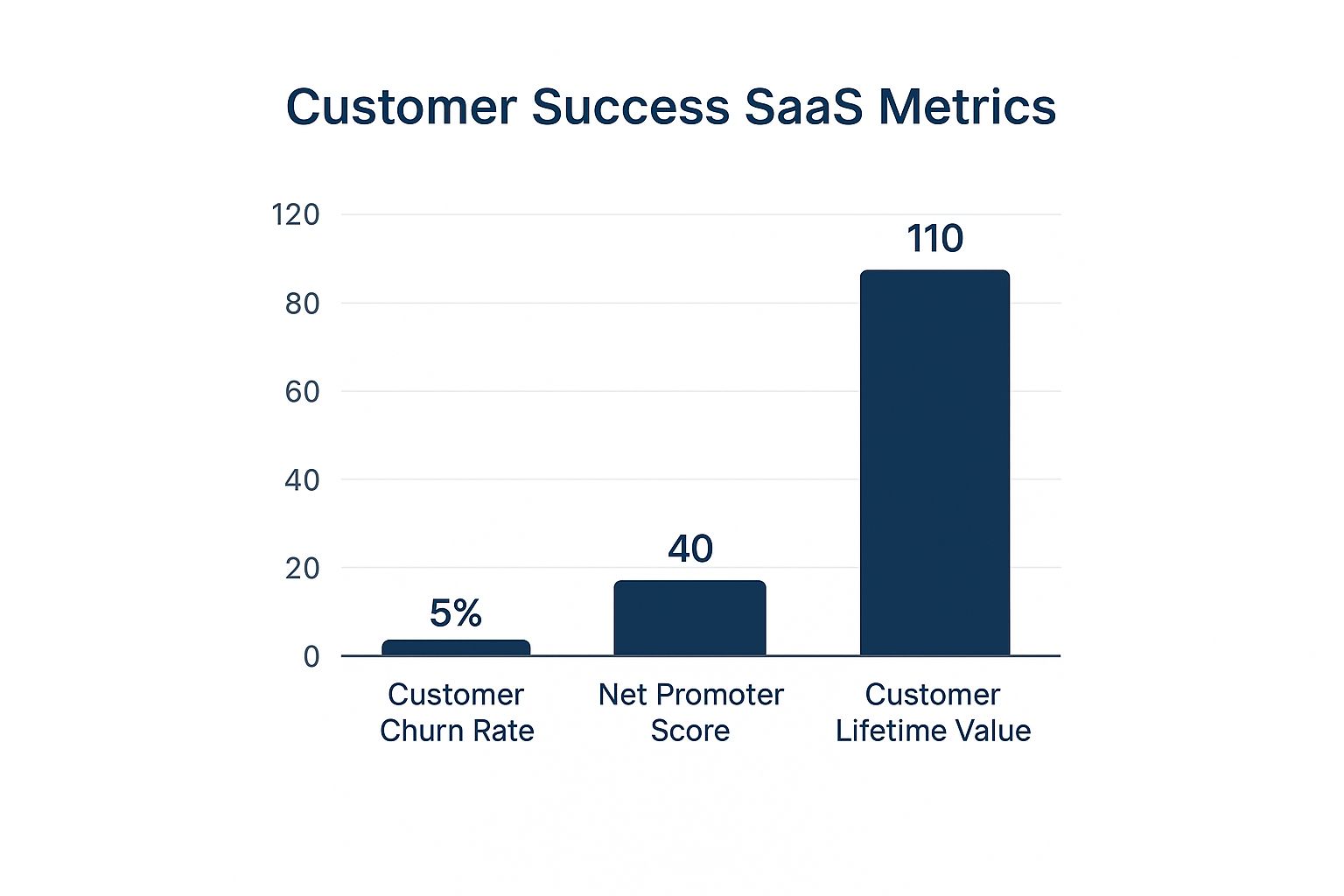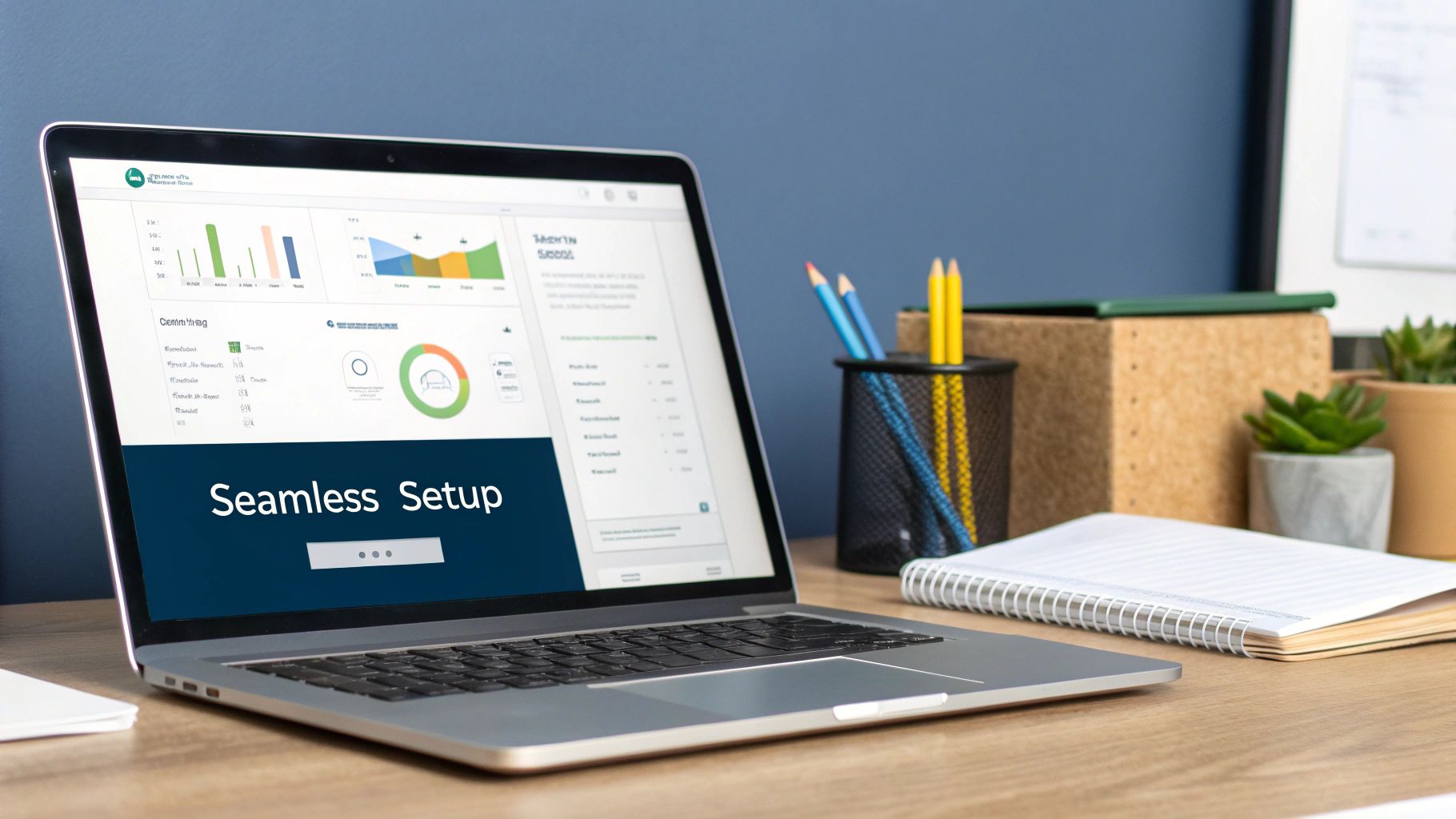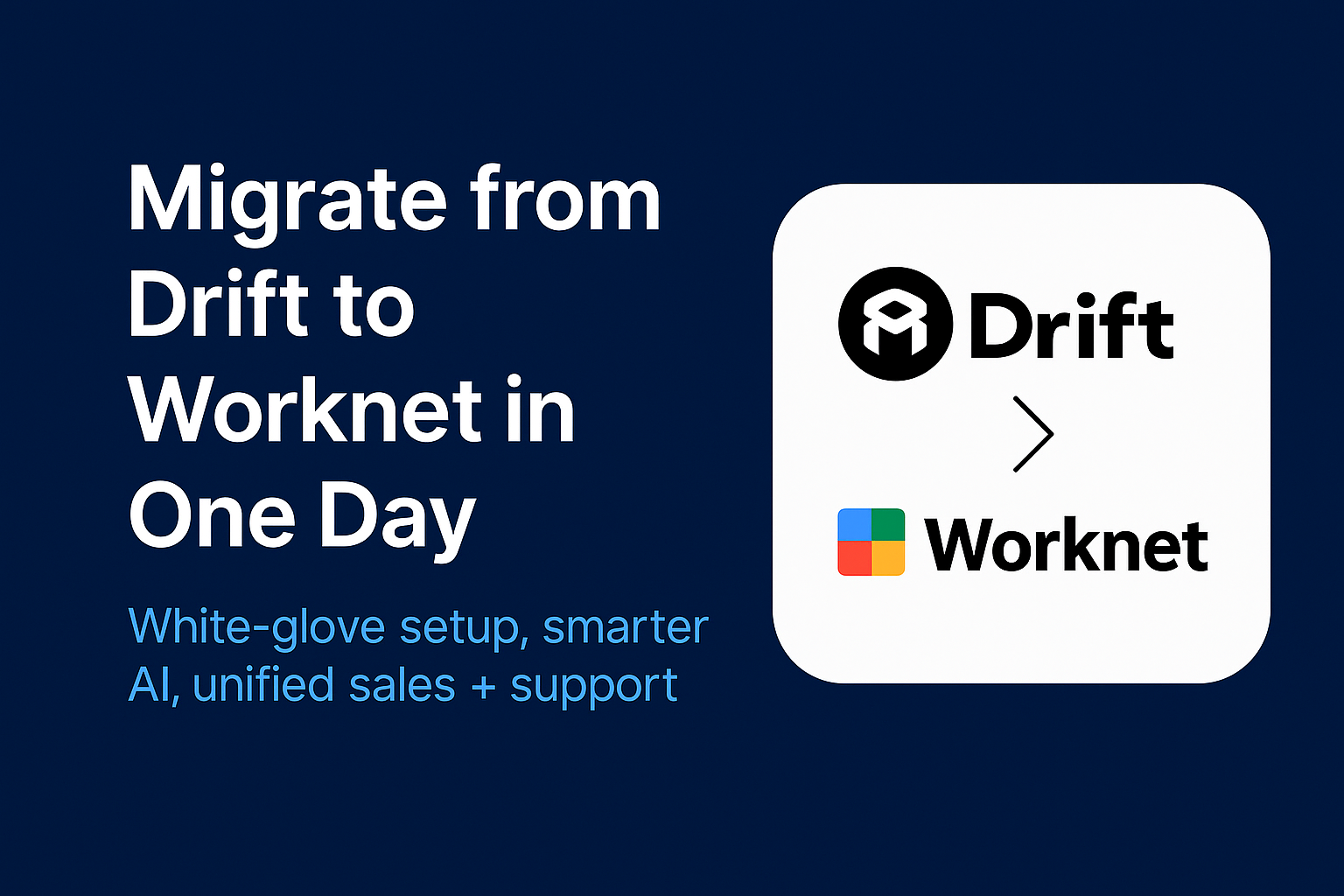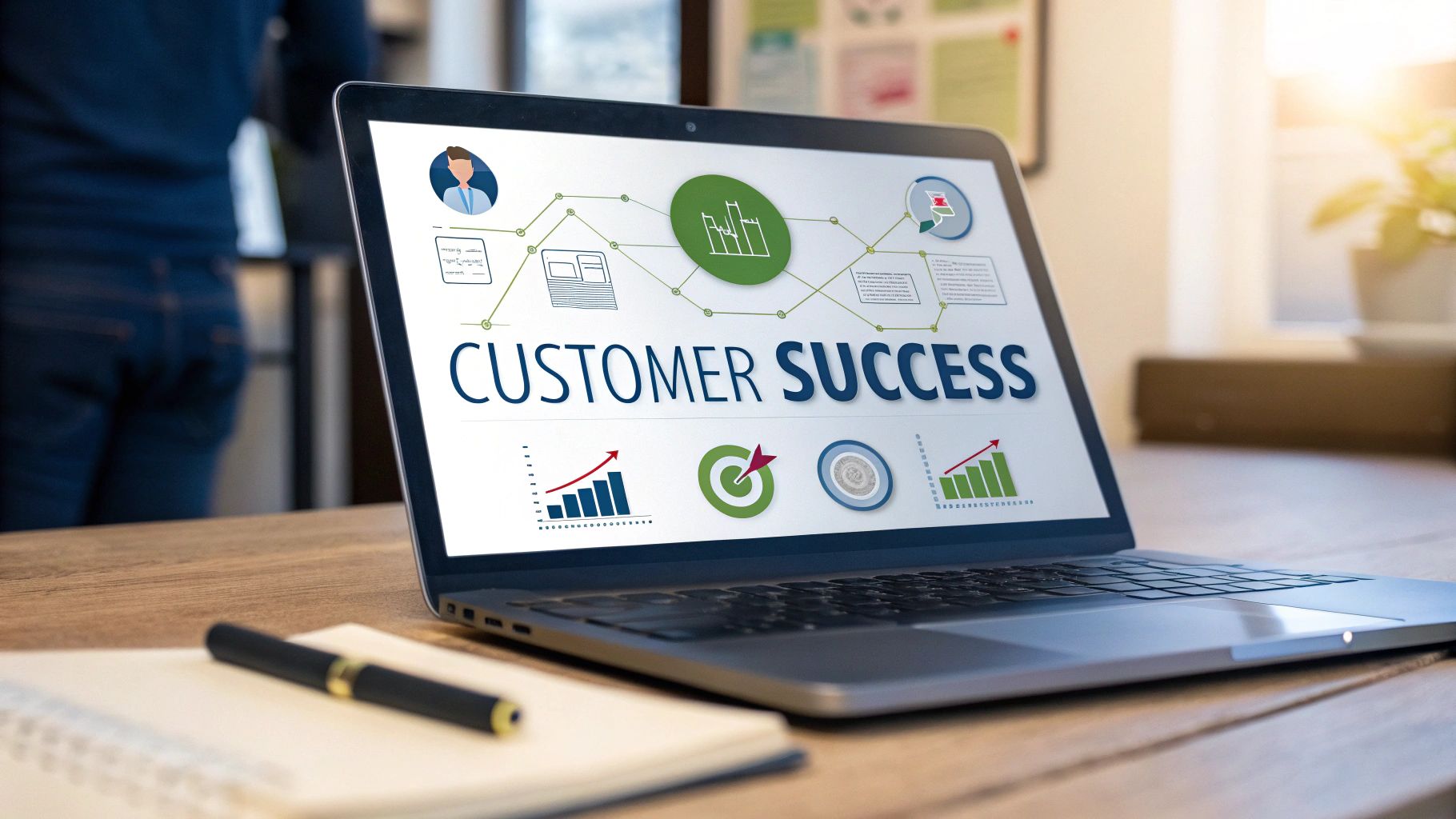Customer Success in SaaS: The Ultimate Guide to Sustainable Growth
In the competitive world of SaaS, customer success isn't just a buzzword—it's the bedrock of a healthy, growing business. It’s a proactive game plan focused on making sure your customers get exactly what they hoped for (and more) from your product. This goes way beyond simple customer support; it’s about actively guiding users to value and building real, lasting partnerships.
For any subscription-based company, this approach is non-negotiable. Strong customer success in SaaS is the engine that drives customer retention and, ultimately, sustainable growth.
What Is Customer Success in SaaS?
At its heart, customer success in SaaS is a company-wide mindset, not just another department siloed off in a corner. It marks a huge pivot from the old days of selling software as a one-time transaction. Back then, the sale was the finish line. Today, it’s the starting gun.
Think of a Customer Success Manager (CSM) like a personal trainer for your software subscription. Customer support is reactive—they're the ones who fix a piece of gym equipment when you report it's broken. A CSM, on the other hand, is proactive. They're with you from the start, creating a custom workout plan (onboarding), checking in on your progress (adoption), and making sure you’re getting the results you signed up for (value realization). It's this ongoing guidance that makes all the difference.
The Proactive Partnership Model
Traditional account management often swoops in only when a contract is about to expire, focusing on renewals or upsells. Customer success is woven into the entire journey, right from day one. This proactive partnership is all about:
- Nailing the onboarding to show off the product's value right out of the gate.
- Keeping an eye on adoption to spot users who are struggling or missing out on powerful features.
- Offering strategic advice to help customers crush their own business goals using your software.
- Building genuine relationships that turn happy customers into passionate brand advocates.
This hands-on approach is crucial in a market where customers can easily jump ship to a competitor. And as software has shifted to subscription models, the stakes have only gotten higher. In fact, research shows that 80% of customers now say the experience a company provides is just as important as its products. What's more, 76% of customers expect companies to understand their specific needs—a role tailor-made for a great customer success team. You can dig into more numbers like these in these customer success statistics on custify.com.
Customer success is not about making customers happy. It's about making them successful. A happy customer might churn, but a successful customer—one who is achieving tangible results—is far more likely to stay, grow, and advocate for your brand.
When you get right down to it, customer success is the driving force behind retention and expansion revenue. It’s the strategic function that nurtures a customer from a tentative new sign-up into a long-term partner. By relentlessly focusing on what your customers want to achieve, SaaS companies can beat churn, boost lifetime value, and build a powerful foundation for growth.
Why Customer Success Is the Engine for Sustainable SaaS Growth
Sure, proactive guidance leads to happy customers, but the real magic of customer success in SaaS is how it directly fuels financial growth. Think of it as the economic engine humming behind the scenes, turning customer loyalty into predictable, recurring revenue. In the subscription world, simply landing new customers isn't the finish line. Real, sustainable growth comes from keeping the customers you already have and helping them succeed so much that they want to grow with you.
This is where the numbers start to tell the full story. Instead of being solely focused on bringing in new logos, the smartest SaaS companies are obsessed with metrics like Net Revenue Retention (NRR) and Customer Acquisition Cost (CAC). A well-oiled customer success program is the single best way to move both of these metrics in the right direction.

The Power of Negative Churn
One of the most powerful—and sought-after—concepts in SaaS is negative churn.
Picture your business as a bucket filled with water, which represents your revenue. Churn is the water leaking out as customers cancel their subscriptions. Negative churn is what happens when the new revenue you add from your existing customers—through upsells, cross-sells, and upgrades—is greater than the revenue you lose from the customers who leave.
In short, your existing customer base becomes its own growth engine. Even if you didn’t sign a single new customer this month, your revenue would still go up. This is the holy grail for any SaaS business, and it’s a goal achieved almost entirely through great customer success.
When CSMs make sure customers are getting massive value from your product, they naturally uncover opportunities for expansion. They might spot a team that could use a few more seats or introduce a premium feature that solves another critical business problem for the client.
Reducing Churn and Its Financial Leverage
Preventing customers from walking out the door is one of the most capital-efficient ways to grow a company. Bringing in a new customer is expensive—you have marketing spend, sales commissions, and onboarding costs. Keeping an existing one? Far, far cheaper.
The numbers don't lie. While typical annual churn rates in SaaS hover around 5% to 7%, every single percentage point has a massive impact. Research consistently shows that cutting churn by just 5% can boost profitability by up to 95%. That figure is staggering, and it proves that customer success isn't a cost center; it's a core revenue driver. It's no surprise that 85% of SaaS budgets often go toward renewing existing subscriptions—companies know where the real value lies. You can dig into more data on the financial impact of SaaS retention at Zylo.com.
This kind of financial leverage is exactly why a proactive strategy is so important.
Improving Capital Efficiency
By focusing on retaining and expanding customer accounts, customer success directly eases the pressure on your Customer Acquisition Cost (CAC) payback period. When customers stick around longer and spend more over time, the value of every new customer you acquire goes up exponentially.
This kicks off a powerful cycle of healthy, sustainable growth:
- Lower Churn: Proactive engagement and support keep more customers on board.
- Higher Lifetime Value (LTV): Happy customers stay longer and are far more open to buying more.
- Improved LTV/CAC Ratio: The ultimate health metric for any SaaS business model gets a serious boost.
For any SaaS company serious about scaling responsibly, investing in customer success isn't just a nice-to-have—it's a financial imperative. To learn more about how technology can supercharge these efforts, check out our guide on using AI for customer success strategies. It offers a clear roadmap for using automation to deliver exceptional experiences at scale.
How to Measure Customer Success Performance
If you want to get a real handle on customer success in SaaS, you have to measure it. Gut feelings and a few good customer stories are nice, but they won't help you make the tough strategic calls. Measuring performance is what moves your team from hoping for success to actually engineering it.
Think of it as building a dashboard for your customer relationships. It should tell you a clear story: where are things strong, where are they starting to weaken, and where is your next big opportunity hiding? Without the right metrics, you’re just flying blind.
Tracking the Most Important SaaS Metrics
The sheer number of metrics you could track can feel overwhelming. The key is to zero in on the handful that are truly non-negotiable for a SaaS customer success team. These aren't just fancy acronyms; each one gives you a unique window into the health of your customer base.
Focusing on the right KPIs helps you spot problems before they turn into fires. A sudden dip in a key metric is an early warning flare, giving your team the chance to step in and help, rather than scrambling to save an account that's already halfway out the door. This data-first approach is what makes customer success scalable and predictable.
The image below breaks down three of the most crucial metrics in the SaaS world: Customer Churn Rate, Net Promoter Score (NPS), and Customer Lifetime Value (CLV).

This really highlights the balancing act teams have to perform—keeping churn low while simultaneously building loyalty and maximizing the long-term value each customer brings.
To give you a clearer picture, here’s a breakdown of the essential metrics every customer success team should have on their radar.
Essential Customer Success SaaS Metrics Explained
These metrics work together to give you a complete, 360-degree view of your customer relationships, turning raw data into actionable insights.
Breaking Down Churn and Retention
Churn Rate is probably the most famous—and feared—metric in SaaS. It’s simply the rate at which you lose customers. A high churn rate is a major red flag, often signaling that you're not delivering on your promises. To get ahead of this, you'll need solid strategies, which we cover in our guide to boost your customer retention.
On the other side of the coin is Net Revenue Retention (NRR), which many consider the gold standard for healthy, sustainable growth. NRR tells you how much your revenue from existing customers grew or shrank. If your NRR is over 100%, it means you're growing revenue from your current customer base faster than you're losing it from cancellations. That's a powerful position to be in.
The real magic happens when you achieve "negative churn." This is when the expansion revenue from your current customers (upsells, cross-sells) is greater than the revenue you lose from customers who leave. It effectively turns your customer base into its own growth engine.
Building a Predictive Customer Health Score
While metrics like churn and NRR tell you what happened in the past, a Customer Health Score is all about predicting the future. It’s a custom-built metric designed to flag at-risk customers before they even think about canceling.
There's no one-size-fits-all formula here. You have to build a score that reflects what "healthy" and "successful" actually look like for your specific customers.
A good health score typically pulls from several data sources:
- Product Usage: How often are they logging in? Are they using the "sticky" features that deliver the most value? What does their overall adoption look like?
- Support Tickets: Are they submitting a lot of tickets? Has the severity of their issues increased recently? A sudden spike can signal growing frustration.
- Customer Feedback: What are their latest Net Promoter Score (NPS) or Customer Satisfaction (CSAT) scores telling you?
- Billing Information: Are their payments on time? Delinquent payments can be a sign of disengagement.
By combining and weighting these factors, you can assign a simple score (often color-coded like green, yellow, or red) to every account. This allows your team to stop fighting fires and start preventing them, focusing their energy on the customers who need them most.
Building Your Proactive Customer Success Strategy
The biggest leap a SaaS customer success team can make is moving from reactive fire-fighting to proactive guidance. Instead of just answering support tickets and putting out fires, a proactive strategy means you’re always one step ahead, anticipating what your customers need to succeed. This isn’t about reading minds; it’s about building a deliberate framework that steers them toward value.
This entire motion breaks down into three core phases: Onboarding, Adoption, and Expansion. By engineering a clear win for the customer at each of these stages, you create a powerful, repeatable engine for growth that systematically cuts down on churn.

Onboarding: The First "Aha!" Moment
Nothing matters more than a customer's first few interactions with your product. Onboarding isn't a simple product tour—it’s a race to get them to their first "aha!" moment. This is the critical point where the value you promised during the sales process becomes real and tangible for them.
A great onboarding experience feels like it was designed just for them. It should be personal, tied to their specific goals, and laser-focused on delivering a quick win. The aim is to make your new customer feel smart and capable, reinforcing that they made an excellent choice in picking your tool.
Here are a few ways to engineer that first moment of value:
- Segmented Onboarding Tracks: Don't give everyone the same tour. Create unique onboarding paths based on a user’s role or their stated goals. A marketing manager and a data analyst need to see completely different features first.
- In-App Checklists: Interactive checklists are fantastic for guiding users through essential setup steps. They provide a clear path forward and a satisfying sense of accomplishment.
- Welcome Calls: For high-value accounts, there's no substitute for a personal call from a CSM. Use this time to define what success looks like for them, setting the stage for a strong partnership from day one.
Adoption: Driving Deeper Engagement
Once a customer is successfully onboarded, your focus has to shift to adoption. It’s not enough for them to just log in; you need them actively using the key features that deliver the most value. Low adoption is one of the biggest red flags for churn—if your tool isn’t deeply embedded in their daily workflow, they won't have a compelling reason to renew.
Proactive adoption is all about the data. By keeping an eye on product usage, you can spot accounts that are neglecting crucial features or showing early signs of disengagement. This gives your team a chance to step in before a customer gets frustrated or, even worse, apathetic. Understanding this behavior is key, and you can get a better sense of how to track it by looking into the best website visitor tracking tools for 2025 reviewed.
Proactive outreach during the adoption phase isn't about checking a box. It's about re-engaging a customer with targeted, value-added content that addresses a specific need or unlocks a new capability they might have missed.
Here are some proven tactics to drive deeper product adoption:
- Usage-Triggered Emails: Set up automated emails that go out when a user hasn't touched a key feature after a certain amount of time. A quick email with a link to a short tutorial video can make all the difference.
- Feature Adoption Campaigns: Got a powerful but underused feature? Run a targeted campaign promoting it to the right customer segments, highlighting exactly how it can solve their problems.
- Office Hours and Webinars: Host regular training sessions or casual "ask me anything" office hours. It’s a great way to handle common questions at scale and show off more advanced functionality.
Expansion: Creating Pathways to Growth
This is where customer success goes from being a cost center to a full-blown revenue engine. Expansion is all about spotting opportunities for upsells and cross-sells. When your customers are hitting their goals left and right thanks to your product, talking about expansion feels like a natural next step, not a sleazy sales pitch.
The secret to successful expansion is proving undeniable ROI. The best tool in your arsenal for this is the Executive Business Review (EBR). This isn't just a check-in call; it's a strategic, data-rich meeting with key stakeholders where you review their progress, showcase the value you’ve delivered, and map out the future together.
A powerful EBR is always data-driven and forward-looking.
- Review Past Performance: Kick things off with clear data showing how your product helped them hit their goals since your last conversation.
- Demonstrate ROI: Draw a direct line from their usage of the product to their business outcomes. Use their own metrics whenever you can to make it hit home.
- Align on Future Goals: Shift the conversation to their upcoming priorities. This is your chance to strategically introduce new features or premium plans that will help them get there even faster.
By running structured EBRs, you change the renewal conversation from one about cost to one about value and partnership. You create a natural ramp to expansion by proving that investing more with you is the smartest move they can make for their continued success.
Using AI and Automation to Scale Customer Success
As your company grows, so does the pressure on your customer success team. What works for 100 customers—that personal, high-touch experience—starts to crumble when you hit 1,000, and it's nearly impossible at 10,000. You simply can't scale by hiring more people to manually track health scores and send onboarding emails.
This is exactly where technology steps in. The goal isn't to replace your Customer Success Managers (CSMs). It's to supercharge them. By using AI and automation, you can handle the repetitive, everyday tasks, freeing up your team to focus on what really matters: building relationships and driving strategic growth. You shift from a one-to-one model to a powerful one-to-many approach.
Automating Proactive Interventions
One of the biggest wins you get from automation is the power to act on customer data the moment it changes. Modern customer success platforms can be your eyes and ears, constantly analyzing product usage, support ticket volume, and dozens of other health signals.
This round-the-clock monitoring allows you to build automated workflows that step in at just the right time. Your tech stack essentially becomes a vigilant co-pilot for your CS team.
- Flagging At-Risk Accounts: Imagine an AI model noticing a customer's logins have dropped off or that they've stopped using a key feature. Instead of a CSM finding out weeks later, the system can instantly flag the account, create a task for the CSM, and provide the context needed to reach out effectively.
- Triggering Helpful Content: When a user starts poking around a new, more advanced feature, an automated email can pop into their inbox with a quick tutorial video. This kind of proactive guidance smooths out the learning curve and prevents frustration before it even starts.
- Celebrating Wins: Automation isn’t just for spotting problems. When a customer hits a major milestone—like completing their first big project—a personalized, automated message can celebrate that win with them, reinforcing the value they’re getting from your product.
Scaling Communication with AI-Powered Chat
Your customers have questions, and they want answers now. Having your highly-skilled CSMs spend their day answering the same basic questions over and over is a huge drain on their time and talent. This is where an AI-powered chat assistant becomes a game-changer.
You can train an intelligent chatbot on your entire knowledge base, support articles, and product docs. It can then provide instant, accurate answers 24/7, letting your human team focus on the complex, consultative conversations that truly require their expertise.
Technology empowers a CSM to move from being a reactive problem-solver to a proactive strategic advisor. By handling the routine tasks, AI and automation give them the bandwidth to focus on what humans do best: building relationships, understanding nuanced business goals, and driving expansion.
This creates a better experience for everyone. Customers get immediate help for simple issues, and your CSMs can dedicate their valuable time to high-impact activities like running executive business reviews or strategizing with key accounts.
Personalization at Scale
Automation isn't just about being more efficient; it's about making a larger audience feel seen. By segmenting customers based on their behavior, lifecycle stage, or business goals, you can create automated communication streams that feel perfectly tailored to their individual journey.
To get a better handle on the nuts and bolts, it helps to understand what customer service automation is and how it works behind the scenes. It’s this smart application of tech that lets a small team deliver a personal touch to thousands of users.
Ultimately, weaving AI and automation into your customer success saas strategy isn't a luxury—it's essential for growth. It’s how you maintain a high standard of service as you scale, ensuring no customer gets left behind.
Common Questions About SaaS Customer Success
As you start to build or grow your customer success function, the big-picture theory quickly gives way to practical questions. Making the leap from concept to execution means you'll have to tackle some common hurdles head-on. Getting these fundamentals right from the start is absolutely critical for building a strong foundation and getting your team pointed in the right direction.
Let's walk through some of the most frequent questions we hear from SaaS leaders to help you move forward with confidence.

What Is the Difference Between Customer Support and Customer Success?
This is easily the most common question, and the distinction is vital. It all boils down to one simple difference: one is reactive, and the other is proactive.
Think of it this way: Customer Support is your company’s emergency room. When a customer runs into a specific, urgent problem—a software bug, a billing question, or a feature that’s not working—they call support. The support team are experts at triage and resolution. They put out fires as they pop up.
Customer Success, on the other hand, is the preventative care doctor. Their entire job is to keep customers healthy so they never need the emergency room in the first place. A Customer Success Manager (CSM) acts as a strategic partner, guiding customers to hit their goals, encouraging them to use more of the product, and building a genuine relationship that breeds loyalty and growth.
When Should a Startup Hire Its First Customer Success Manager?
This is a classic timing question. Hire a CSM too early, and you're burning cash. Wait too long, and you start losing customers you could have saved. The answer isn’t a specific date on a calendar but a response to clear business signals.
The biggest sign is when the founders can no longer personally manage every important customer relationship. This breaking point often happens around the 15-25 customer mark or when you cross a milestone like $20k in monthly recurring revenue (MRR). At that stage, you simply have too many customer needs to handle in an ad-hoc way.
Bringing on a CSM early isn't just about offloading work. It instills a customer-centric mindset into your company's DNA, helps you formalize a repeatable onboarding process, and creates an invaluable feedback channel straight to your product team. It's an investment in your future, not just a cost for today.
How Do You Create a Customer Health Score?
A customer health score is your early warning system. It’s a data-driven metric that gives you an at-a-glance look at an account's well-being, often boiled down to a simple rating like red, yellow, or green. The goal is to flag at-risk customers before they even think about leaving.
There's no one-size-fits-all formula here; you have to build it around what successful usage of your product actually looks like. That said, most reliable health scores are a mix of a few key ingredients:
- Product Usage Data: This is non-negotiable. You need to be tracking things like how often users log in, how many features they’re using, and how much time they spend in the app.
- Support Ticket History: Are they constantly running into trouble? A sudden jump in the number or severity of support tickets is a major red flag.
- Customer Feedback: Direct feedback from tools like Net Promoter Score (NPS) or Customer Satisfaction (CSAT) surveys gives you a pulse on their sentiment.
- Billing Information: Things like consistently late payments or credit card declines can be a subtle sign that a customer is starting to disengage.
By blending these data points and weighting them appropriately, you can build a predictive model that lets your team get ahead of problems. This shifts your CS function from reacting to cancellations to proactively preventing them.
What Are the Biggest Challenges for a Customer Success Team?
While incredibly valuable, customer success teams face their own unique set of challenges, especially as a company grows. Getting past these roadblocks requires a smart mix of strategy, technology, and rock-solid alignment with other departments.
Time and again, customer success leaders point to the same three major hurdles:
- Scaling Personalized Engagement: You can’t give a high-touch, white-glove experience to thousands of customers without smart tech. Automation and AI are essential for handling the routine check-ins and tasks, freeing up your CSMs to focus on high-value, strategic conversations.
- Proving ROI and Value: Customer success can't just be a "feel-good" department; it has to prove its financial contribution. This means obsessively tracking metrics like Net Revenue Retention (NRR), churn reduction, and expansion revenue to show how CS directly impacts the bottom line.
- Maintaining Internal Alignment: CS is a team sport. It can't operate in a silo. True success depends on constant, seamless collaboration with Sales (for smooth handoffs), Product (for user feedback), and Marketing (for customer stories) to create one cohesive journey.
Navigating these challenges well is what truly separates a good customer success program from a great one.
Ready to supercharge your customer journey from first visit to lifelong advocate? Worknet.ai provides the AI-powered chat assistant that engages visitors, converts trial users, and drives retention at scale. See how you can build better customer relationships by visiting https://worknet.ai.
FAQs
.png)
Lorem ipsum dolor sit amet, consectetur adipiscing elit. Suspendisse varius enim in eros elementum tristique. Duis cursus, mi quis viverra ornare, eros dolor interdum nulla, ut commodo diam libero vitae erat. Aenean faucibus nibh et justo cursus id rutrum lorem imperdiet. Nunc ut sem vitae risus tristique posuere.
Lorem ipsum dolor sit amet, consectetur adipiscing elit. Suspendisse varius enim in eros elementum tristique. Duis cursus, mi quis viverra ornare, eros dolor interdum nulla, ut commodo diam libero vitae erat. Aenean faucibus nibh et justo cursus id rutrum lorem imperdiet. Nunc ut sem vitae risus tristique posuere.
Lorem ipsum dolor sit amet, consectetur adipiscing elit. Suspendisse varius enim in eros elementum tristique. Duis cursus, mi quis viverra ornare, eros dolor interdum nulla, ut commodo diam libero vitae erat. Aenean faucibus nibh et justo cursus id rutrum lorem imperdiet. Nunc ut sem vitae risus tristique posuere.
Lorem ipsum dolor sit amet, consectetur adipiscing elit. Suspendisse varius enim in eros elementum tristique. Duis cursus, mi quis viverra ornare, eros dolor interdum nulla, ut commodo diam libero vitae erat. Aenean faucibus nibh et justo cursus id rutrum lorem imperdiet. Nunc ut sem vitae risus tristique posuere.
Lorem ipsum dolor sit amet, consectetur adipiscing elit. Suspendisse varius enim in eros elementum tristique. Duis cursus, mi quis viverra ornare, eros dolor interdum nulla, ut commodo diam libero vitae erat. Aenean faucibus nibh et justo cursus id rutrum lorem imperdiet. Nunc ut sem vitae risus tristique posuere.
Lorem ipsum dolor sit amet, consectetur adipiscing elit. Suspendisse varius enim in eros elementum tristique. Duis cursus, mi quis viverra ornare, eros dolor interdum nulla, ut commodo diam libero vitae erat. Aenean faucibus nibh et justo cursus id rutrum lorem imperdiet. Nunc ut sem vitae risus tristique posuere.
Lorem ipsum dolor sit amet, consectetur adipiscing elit. Suspendisse varius enim in eros elementum tristique. Duis cursus, mi quis viverra ornare, eros dolor interdum nulla, ut commodo diam libero vitae erat. Aenean faucibus nibh et justo cursus id rutrum lorem imperdiet. Nunc ut sem vitae risus tristique posuere.
Lorem ipsum dolor sit amet, consectetur adipiscing elit. Suspendisse varius enim in eros elementum tristique. Duis cursus, mi quis viverra ornare, eros dolor interdum nulla, ut commodo diam libero vitae erat. Aenean faucibus nibh et justo cursus id rutrum lorem imperdiet. Nunc ut sem vitae risus tristique posuere.
Lorem ipsum dolor sit amet, consectetur adipiscing elit. Suspendisse varius enim in eros elementum tristique. Duis cursus, mi quis viverra ornare, eros dolor interdum nulla, ut commodo diam libero vitae erat. Aenean faucibus nibh et justo cursus id rutrum lorem imperdiet. Nunc ut sem vitae risus tristique posuere.
Lorem ipsum dolor sit amet, consectetur adipiscing elit. Suspendisse varius enim in eros elementum tristique. Duis cursus, mi quis viverra ornare, eros dolor interdum nulla, ut commodo diam libero vitae erat. Aenean faucibus nibh et justo cursus id rutrum lorem imperdiet. Nunc ut sem vitae risus tristique posuere.


.svg)


.webp)
.webp)
.webp)




